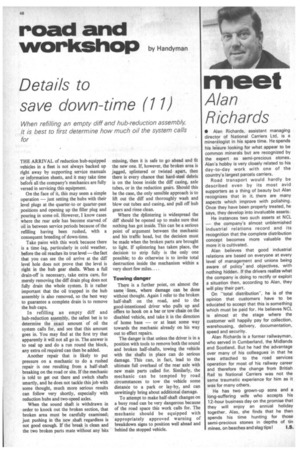Details to save down-time (17)
Page 50

If you've noticed an error in this article please click here to report it so we can fix it.
When refilling an empty duff and hub-reduction assembly, it is best to first determine how much oil the system ca//s for
THE ARRIVAL of reduction hub-equipped vehicles in a fleet is not always backed up right away by supporting service manuals or information sheets, and it may take time befoile all the company's mechanics are fully versed in servicing this equipment.
On the face of it, this may seem a simple operation — just setting the hubs with their level plugs at the quarter-to or quarter-past positions and opening up the filler plug and pouring in some oil. However, I know cases where the rear axle has become starved of oil in between service periods because of the refilling having been rushed, with a consequent breeding of down-time.
Take pains with this work because there is a time .lag, particularly in cold weather, before the oil reaches its true level —the fact that you can see the oil arrive at the diff level hole does not prove that the level is right in the hub gear shells. When a full drain-off is necessary, take extra care, for merely removing the cliff drain plug does not fully drain the whole system. It is rather important that the oil trapped in the hub assembly is also removed, so the best way to guarantee a complete drain is to remove the hub caps.
In refilling an empty diff and hub-reduction assembly, the safest bet is to determine the exact amount of oil the system calls for, and see that this amount goes in. You may find at the first try that apparently it will not all go in. The answer is to seal up and do a run round the block, any extra oil required can then be added.
Another repair that is likely to put pressure on a mechanic to do a rushed repair is one resulting from a half-shaft breaking on the road or site. If the mechanic is told to get out there and switch shafts smartly, and he does not tackle this job with some thought, much more serious results can follow very shortly, especially with reduction hubs and two-speed axles.
When the sound shaft is withdrawn in order to knock out the broken section, that broken area must be carefully examined; just pushing in the new shaft regardless is not good enough. If the break is clean and the two broken parts mate without any bits missing, then it is safe to go ahead and fit the new one. If, however, the broken area is jagged, splintered or twisted apart, then there is every chance that hard-steel debris is on the loose inside the diff casing, axle tubes, or in the reduction gears. Should this be the case, the only sensible approach is to lift out the cliff and thoroughly wash and blow out tubes and casing, and pull off hub gears and rinse clean.
Where the s'plintering is widespread the diff should be opened up to make sure that nothing has got inside. This can be a serious point of argument between the mechanic and his traffic head, but the decision must be made when the broken parts are brought to light. If splintering has taken place, the decision to strip fully is the only one possible; to do otherwise is to invite total destruction inside the mechanism within a very short few miles....
Towing danger There is a further point, on almost the same lines, where damage can be done without thought. Again I refer to the broken half-shaft on the road, and to the good-intentioned driver who pulls up and offers to hook on a bar or tow chain on the disabled vehicle, and take it in the direction of home base — or at least some way towards the mechanic already on his way out to effect repairs.
The danger is that unless the driver is in a position with tools to remove both the sound and broken half-shafts, towing the vehicle with the shafts in place can do serious damage. This can, in fact, lead to the ultimate full overhaul of the rear axle with new main parts called for. Similarly, the mechanic can be tempted by road circumstances to tow the vehicle some distanee to a park or lay-by, and can unwittingly bring about additional damage.
To attempt to make half-shaft changes on a busy road can be very dangerous because of the road space this work calls for. The mechanic should be equipped with appropriately approved warning of breakdown signs to position well ahead and behind the stopped vehicle.




































































































